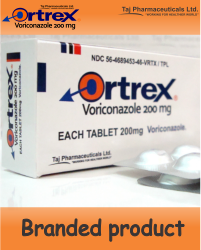FULL PRESCRIBING INFORMATION - DOSAGE AND ADMINISTRATION

Ortrex Details
Contact Us
Taj Pharma India Brands
Taj Pharma Group (India)
214, Bake House, Bake House Lane,
Fort, Mumbai 400001, India.
E-mail: ortrex@tajpharma.com




DOSAGE AND ADMINISTRATION
 Instructions for Use in All Patients
Instructions for Use in All Patients
ORTREX Voriconazole Tablets or Oral Suspension should be taken at least one hour before or after a meal.
ORTREX Voriconazole I.V. for Injection requires reconstitution to 10 mg/mL and subsequent dilution to 5 mg/mL or less prior to administration as an infusion, at a maximum rate of 3 mg/kg per hour over 1 to 2 hours.
Do not administer as an IV bolus injection.
Use of ORTREX Voriconazole I.V. With Other Parenteral Drug Products
Blood products and concentrated electrolytes
ORTREX Voriconazole I.V. must not be infused concomitantly with any blood product or short-term infusion of concentrated electrolytes, even if the two infusions are running in separate intravenous lines (or cannulas). Electrolyte disturbances such as hypokalemia, hypomagnesemia and hypocalcemia should be corrected prior to initiation of ORTREX Voriconazole therapy [see Warnings and Precautions ].
Intravenous solutions containing (non-concentrated) electrolytes
ORTREX Voriconazole I.V. can be infused at the same time as other intravenous solutions containing (non-concentrated) electrolytes, but must be infused through a separate line.
Total parenteral nutrition (TPN)
ORTREX Voriconazole I.V. can be infused at the same time as total parenteral nutrition, but must be infused in a separate line. If infused through a multiple-lumen catheter, TPN needs to be administered using a different port from the one used for ORTREX Voriconazole I.V.
Recommended Dosing in Adults
Invasive aspergillosis and serious fungal infections due to Fusarium spp. and Scedosporium apiospermum
Therapy must be initiated with the specified loading dose regimen of intravenous ORTREX Voriconazole on Day 1 followed by the recommended maintenance dose regimen. Intravenous treatment should be continued for at least 7 days. Once the patient has clinically improved and can tolerate medication given by mouth, the oral tablet form or oral suspension form of ORTREX Voriconazole may be utilized. The recommended oral maintenance dose of 200 mg achieves a ORTREX Voriconazole exposure similar to 3 mg/kg IV; a 300 mg oral dose achieves an exposure similar to 4 mg/kg IV. Switching between the intravenous and oral formulations is appropriate because of the high bioavailability of the oral formulation in adults [see Clinical Pharmacology].
Candidemia in non-neutropenic patients and other deep tissue Candida infections
Patients should be treated for at least 14 days following resolution of symptoms or following last positive culture, whichever is longer.
Esophageal Candidiasis
Patients should be treated for a minimum of 14 days and for at least 7 days following resolution of symptoms.
Dosage Adjustment
If patient response is inadequate, the oral maintenance dose may be increased from 200 mg every 12 hours (similar to 3 mg/kg IV q12h) to 300 mg every 12 hours (similar to 4 mg/kg IV q12h). For adult patients weighing less than 40 kg, the oral maintenance dose may be increased from 100 mg every 12 hours to 150 mg every 12 hours. If patient is unable to tolerate 300 mg orally every 12 hours, reduce the oral maintenance dose by 50 mg steps to a minimum of 200 mg every 12 hours (or to 100 mg every 12 hours for adult patients weighing less than 40 kg).
If patient is unable to tolerate 4 mg/kg IV q12h, reduce the intravenous maintenance dose to 3 mg/kg q12h.
The maintenance dose of voriconazole should be increased when coadministered with phenytoin or efavirenz [see Drug Interactions].
The maintenance dose of voriconazole should be reduced in patients with mild to moderate hepatic impairment, Child-Pugh Class A and B [see Dosage and Administration ]. There are no PK data to allow for dosage adjustment recommendations in patients with severe hepatic impairment (Child-Pugh Class C). Duration of therapy should be based on the severity of the patient’s underlying disease, recovery from immunosuppression and clinical response.
Use in Patients with Hepatic Impairment
In the clinical program, patients were included who had baseline liver function tests (ALT, AST) up to 5 times the upper limit of normal. No dose adjustment is necessary in patients with this degree of abnormal liver function, but continued monitoring of liver function tests for further elevations is recommended [see Warnings and Precautions].
It is recommended that the standard loading dose regimens be used but that the maintenance dose be halved in patients with mild to moderate hepatic cirrhosis (Child-Pugh Class A and B) [see Clinical Pharmacology].
Voriconazole tablets have not been studied in patients with severe hepatic cirrhosis (Child-Pugh Class C) or in patients with chronic hepatitis B or chronic hepatitis C disease. Voriconazole tablets have been associated with elevations in liver function tests and clinical signs of liver damage, such as jaundice and should only be used in patients with severe hepatic impairment if the benefit outweighs the potential risk. Patients with hepatic insufficiency must be carefully monitored for drug toxicity.
Use in Patients with Renal Impairment
The pharmacokinetics of orally administered voriconazole are not significantly affected by renal impairment. Therefore, no adjustment is necessary for oral dosing in patients with mild to severe renal impairment [see Clinical Pharmacology].
In patients with moderate or severe renal impairment (creatinine clearance < 50 mL/min), accumulation of the intravenous vehicle, SBECD, occurs. Oral voriconazole should be administered to these patients, unless an assessment of the benefit/risk to the patient justifies the use of intravenous voriconazole. Serum creatinine levels should be closely monitored in these patients, and, if increases occur, consideration should be given to changing to oral voriconazole therapy [see Warnings and Precautions ].
Voriconazole is hemodialyzed with clearance of 121 mL/min. The intravenous vehicle, SBECD, is hemodialyzed with clearance of 55 mL/min. A 4-hour hemodialysis session does not remove a sufficient amount of voriconazole to warrant dose adjustment.
Download Ortrex Overview
Ortrex® Voriconazole 200mg tablets are a prescription medicine used to treat certain serious fungal infections in your blood and body. Ortrex® Voriconazole 200mg tablets sold by Taj Pharmaceuticals Limited (India), a global pharmaceuticals company. It is available in India, Middle East and a few other South Asian countries.
![]() Ortrex® Voriconazole 200mg tablets_CMI
Ortrex® Voriconazole 200mg tablets_CMI
![]() Ortrex® Voriconazole 200mg tablets_FPI
Ortrex® Voriconazole 200mg tablets_FPI


 Home
Home